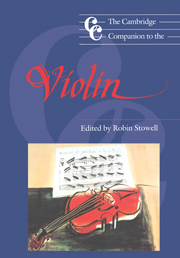Book contents
- Frontmatter
- 1 The violin and bow – origins and development
- 2 The physics of the violin
- 3 The violinists of the Baroque and Classical periods
- 4 The nineteenth-century bravura tradition
- 5 The twentieth century
- 6 The fundamentals of violin playing and teaching
- 7 Technique and performing practice
- 8 Aspects of contemporary technique (with comments about Cage, Feldman, Scelsi and Babbitt)
- 9 The concerto
- 10 The sonata
- 11 Other solo repertory
- 12 The violin as ensemble instrument
- 13 The pedagogical literature
- 14 The violin – instrument of four continents
- 15 The violin in jazz
- Appendix Principal violin treatises
- Glossary of technical terms
- Notes
- Select bibliography
- Index
3 - The violinists of the Baroque and Classical periods
Published online by Cambridge University Press: 28 September 2011
- Frontmatter
- 1 The violin and bow – origins and development
- 2 The physics of the violin
- 3 The violinists of the Baroque and Classical periods
- 4 The nineteenth-century bravura tradition
- 5 The twentieth century
- 6 The fundamentals of violin playing and teaching
- 7 Technique and performing practice
- 8 Aspects of contemporary technique (with comments about Cage, Feldman, Scelsi and Babbitt)
- 9 The concerto
- 10 The sonata
- 11 Other solo repertory
- 12 The violin as ensemble instrument
- 13 The pedagogical literature
- 14 The violin – instrument of four continents
- 15 The violin in jazz
- Appendix Principal violin treatises
- Glossary of technical terms
- Notes
- Select bibliography
- Index
Summary
During the seventeenth and eighteenth centuries the violin underwent an astonishing transformation of role. A lowly dance instrument at the beginning of the period, it had by 1800 become a dominant force in Western musical culture. Virtuoso violinists were feted at court and public concert alike, and only singers were more highly rewarded. While none could perhaps be placed among the very front rank of composers, many violinists were important creative figures, including Heinrich von Biber, Arcangelo Carelli, Antonio Vivaldi and Giovanni Battista Viotti. Indeed the instrument's capabilities influenced the course of musical style itself, to the extent that singers in the early eighteenth century were expected to be able to rival the figurations of violin music. The period also saw the establishment of the string basis of the orchestra, and violinists such as Jean-Baptiste Lully and Johann Stamitz played a major part in the refinement of orchestral discipline. In addition the violin was accepted during the eighteenth century as an accomplishment for gentlemen amateurs.
These developments were closely tied in with those of musical life in general. Early-seventeenth-century Italy was a hotbed of experiment, culminating in the operatic masterpieces of Monteverdi. The violin was the only instrument fully able to match the voice in the new aesthetic, which favoured a subjective and strongly projected individuality, expressed in a dramatic ‘affective’ idiom, with exuberant virtuosity and ornamentation. Both violinists and style spread through Austria and Germany, but the new Italian manner was rejected in seventeenth-century France, and only guardedly accepted in England.
- Type
- Chapter
- Information
- The Cambridge Companion to the Violin , pp. 46 - 60Publisher: Cambridge University PressPrint publication year: 1992



